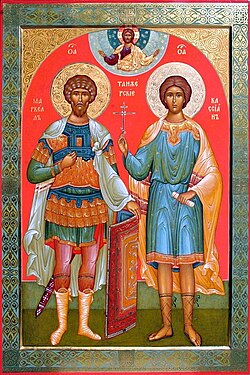Marcellus of Tangier
| Saint Marcellus of Tangier | |
|---|---|

Icon of Saint Marcellus located in the Russian Orthodox Church of the Resurrection, Rabat
|
|
| Martyr | |
| Born | c. mid 3rd century AD |
| Died | 298 AD Tingis, Mauretania Tingitana (modern-day Tangiers, Tangier-Tétouan, Morocco) |
| Venerated in | Catholic Church, Eastern Orthodox Church |
| Canonized | Pre-Congregation |
| Major shrine | Church of San Marcelo, León |
| Feast | October 30 |
| Patronage | the city of León and the Province of León, Spain |
Saint Marcellus of Tangier or Saint Marcellus the Centurion (Spanish: San Marcelo) (c. mid 3rd century – 298 AD) is venerated as a Martyr Saint by the Catholic Church and the Eastern Orthodox Church. His feast day is celebrated on October 30.
Marcellus was said to have been a centurion stationed at Tingis (modern-day Tangiers) who refused to participate in the general birthday celebrations of the Emperor Maximian, which would have entailed sacrifice to the Roman gods. Throwing off his military belt, weapons, and vine staff (the insignia of his rank). Marcellus was soon brought before a judge named Fortunatus. The judge remanded the saint to lay his case before Maximian and Constantius; the latter was friendly to Christians. However, Marcellus was taken to the deputy Praetorian prefect Aurelius Agricolan instead. Marcellus pleaded guilty to repudiating his allegiance to an earthly leader.
Marcellus was martyred with a sword by the deputy Praetorian prefect.
Afterwards, it is said that the official shorthand writer, a man named Saint Cassian, was so angry at the sentence that he refused to record the court proceedings and was martyred as well.
St Marcellus' relics were later brought to and enshrined at León, and he became a patron saint of the city. The Plaza de San Marcelo in this city is named for him. The church of San Marcelo dates from the 10th century.
...
Wikipedia
